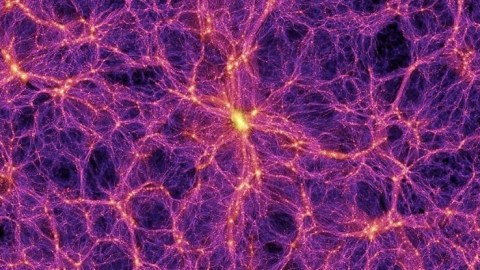What is the cosmic web?

Wikimedia Commons
- Composed of massive filaments of galaxies separated by giant voids, the cosmic web is the name astronomers give to the structure of our universe.
- Why does our universe have this peculiar, web-like structure?
- The answer lies in processes that took place in the first few hundred thousands years after the Big Bang.
Looking up at the night sky, it seems as though the stars and galaxies are spread out in a more or less random fashion. This, however, isn’t really the case. The universe isn’t a random jumble of objects; it has a structure composed of galaxies and gas. Cosmologists call this structure the cosmic web.
The cosmic web is composed of interconnecting filaments of clustered galaxies and gases stretched out across the universe and separated by giant voids. The largest of these filaments that we have found to date is the Hercules–Corona Borealis Great Wall, which is a staggering 10 billion light years long and contains several billion galaxies. As for the voids, the largest is the Keenan, Barger, and Cowie (KBC) void, which has a diameter of 2 billion light years. Within a segment of the spherical KBC void lies the Milky Way galaxy and our planet.
Altogether, these features give the universe a foamy appearance. However, once you zoom out far enough, this pattern disappears, and the universe appears to be a homogeneous chunk of galaxies. Astronomers have a delightful name for this sudden homogeneity — the End of Greatness. At smaller scales, however, we can see that the universe does indeed have a rather magnificent structure. This begs the question: How did this structure come to be?
It starts with a bang
Space itself has fluctuating energy levels. Incredibly small pairs of particles and anti-particles are spontaneously coming into existence and annihilating each other. This “boiling” of space was happening in the early universe as well. Normally, these particle pairs destroy each other, but the rapid expansion of the early universe prevented that from happening. As space expanded, so too did these fluctuations, causing discrepancies in the density of the universe.

A visualization of quantum fluctuations.
Wikimedia Commons
Because matter attracts matter through gravity, these discrepancies explain why matter clumped together in some places and not others. But this doesn’t fully explain the structure of the cosmic web. After the inflationary period (roughly, 10-32 seconds after the Big Bang), the universe was full of primordial plasma clumping together due to the aforementioned discrepancies. As this matter clumped together, it created pressure that counteracted gravity, creating ripples akin to a sound wave in the matter of the universe. Physicists call these ripples baryon acoustic oscillations.
Simply put, these ripples are the product of regular matter and dark matter. Dark matter only interacts with other things through gravity, so the pressure that causes these ripples doesn’t affect it — it stays at the center of ripple, not moving. Regular matter, however, is pushed out. A little under 400,000 years after the Big Bang, the universe has cooled enough such that the pressure pushing the matter out is released through a process called photon decoupling.

An artist’s illustration of the rings formed by baryon acoustic oscillations.
Zosia Rostomian, Lawrence Berkeley National Laboratory
As a result, the matter is locked into place. Some regular matter finds its way back to the center of the ripple due to the gravitational attraction of the dark matter. The result is a bullseye: Matter in the middle and matter in a ring around the middle. Because of this, physicists know that you’re more likely to find a galaxy 500 million light years away from another galaxy than you are to find one 400 or 600 million light years away. Simply put, galaxies tend to be found at the outer rings of these cosmic bullseyes.
Altogether, these processes produced the gigantic web of stuff that compose our universe. Of course, there are many other processes that go into producing the cosmic web, but these fall outside the scope of this article. For those of you interested in observing what this structure would look like, you’re in luck: astronomer Bruno Coutinho and colleagues developed an interactive, 3D visualization of the universe’s structure, which you can access here.
The Cosmic Web, or: What does the universe look like at a VERY large scale?
The Millennium Simulation featured in this clip was run in 2005 by the Virgo Consortium, an international group of astrophysicists from Germany, the United K…





